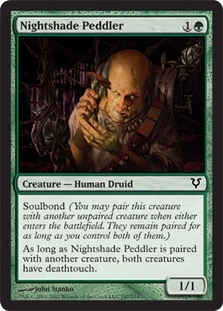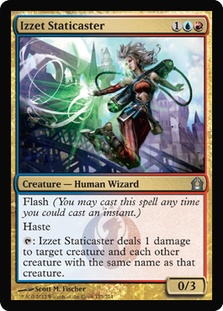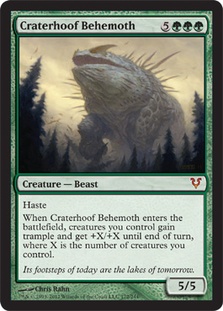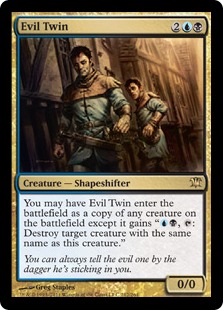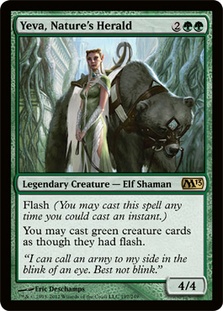It’s been awhile since I wrote about Standard, and it’s time to catch up. Three major events in Standard divided by a few time zones definitely gave us much food for thought, even though my deadline, as usual, doesn’t allow me to know the final results. This past weekend showed us some sweet brews and metagame choices from U/W to Mono-Red. Among all deck types, there was a lack of combo, but now two decks have emerged thanks to Brad Nelson and his Somberwald Sage and PT winner Jan-Moritz Merkel and his Nightshade Peddler. Now the format, despite being heavily influenced by two expensive cards (Thragtusk and Sphinx’s Revelation), allows for playing nearly any kind of strategy.
Creatures (27)
- 4 Olivia Voldaren
- 1 Evil Twin
- 2 Falkenrath Aristocrat
- 3 Huntmaster of the Fells
- 4 Nightshade Peddler
- 1 Zealous Conscripts
- 4 Thragtusk
- 4 Izzet Staticaster
- 4 Deathrite Shaman
Lands (25)
Spells (8)
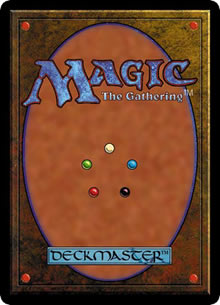
Merkel and his team made a great attempt to break the format, even though I’m a little bit skeptical about the deck’s mana curve. I like the move from the initial Deadeye Navigator RUG to black for Olivia Voldaren, and it has eleven pingers, each of them good as is and insane with Nightshade . That’s very appealing, but the mana curve is 4-12-4-10-4. Moreover, none of the sixteen one- and two-mana spells creates a board presence in the early game, so I expect the deck to have problems with fast aggro. Cheap removal helps, but probably not enough.
The deck is essentially better version of Jund (as it’s much better against Reanimator, especially creature-based), but it has similar weaknesses if it doesn’t draw specific cards. I’d definitely be happy to see it with more reliable mana dorks to complement or even replace Deathrite Shaman and Farseek, but neither Arbor Elf nor Avacyn’s Pilgrim is capable of doing so while the former may actually be the case after the printing of Stomping Ground and Breeding Pool. However, any attempt to try to improve the mana curve makes the deck worse, as nothing can really help and any change makes the deck less concentrated. In this case, I’d prefer to have good game plan, even a fragile one.
The same is true for Reanimator decks. There are many versions played in different colors (Faithless Looting is still capable to win, as proven by John Wade’s Top 8 at SCG Standard Open: Seattle), but regardless of colors, there are two problems to solve: beating graveyard hate and beating control. The second task is about having early pressure while forcing control to hold countermagic mana up and so perform the old “Cursed Scroll and Boil” trick. But if you don’t have Cavern of Souls (which is a little bit problematic in a multicolored deck), it’s hard to do so.
That’s where the Junk version with mana dorks (or even Lotleth Troll) shines. Avacyn’s Pilgrim isn’t generally a good clock, but a pair of them can easily put a control deck into situation where they must sweep the board or do something else at sorcery speed and so give you a window for a big turn. At the same time, Farseek doesn’t provide a board presence and may be too slow against very fast aggressive decks. This obviously is not valid for the matchup against U/W Flash due to Augur of Bolas, but there are other ways to beat that deck. The most promising is to sideboard some cheap threats and to maintain the same strategy at a higher level.
This approach also helps beat graveyard hate, which is vital with its popularity. Brad Nelson used the funky Somberwald Sage as additional way to put fatties into play fast and to beat hate post-board. Nevertheless, as Somberwald Sage is still weak against countermagic, why not play some good creatures and force control decks to deal with each one? They aren’t really good at winning fast, so a single Loxodon Smiter could be threatening enough.
Given the fact that G/W Aggro was the most popular deck at GP Bochum and half of the Top 16 decks at Seattle were various aggro, I’d try to build Reanimator with an increased creature count and the ability to sideboard into a good stuff deck. Craterhoof Behemoth Reanimator even goes as deep as thirteen creatures and two Cavern of Souls in the sideboard, but that may be going too far.
Creatures (19)
Lands (23)
Spells (18)
Sideboard

Fifteen mana dorks and eleven ways to fill the graveyard with eight of them that can also bring Craterhoof Behemoth to your hand sounds interesting. A ton of mana creatures allows digging through your library very fast and then killing the opponent the very turn you resolve Craterhoof Behemoth through potential blockers and pinpoint removal. However, I’d rather have more creatures since I anticipate having to play against aggressive decks. Mono-Red Aggro seems to be nightmare for Craterhoof Behemoth Reanimator, even post-board, as it’s able to deal with a single Thragtusk very easily.
Creatures (23)
- 4 Avacyn's Pilgrim
- 3 Restoration Angel
- 4 Thragtusk
- 3 Lotleth Troll
- 4 Angel of Serenity
- 3 Centaur Healer
- 2 Deathrite Shaman
Lands (24)
Spells (13)

Yes, that’s just another Thragtusk deck, but it tries to go slightly bigger than other Thragtusk decks and simultaneously provide much-needed early pressure against control with Lotleth Troll and Centaur Healer. I could even imagine having our own Rest in Peace in the sideboard for the mirror, but this might be too cute to work (or at least there should be more creatures post-board).
Closing the Reanimator section, I have a few words about the blue version that’s recently gained popularity on Magic Online. I expect it to be overshadowed by Somberwald Sage for some time, but it still has some interesting features compared to other Reanimator decks. It’s slower (which isn’t good against Zombies) but better against graveyard hate, as its digging cards allows putting threats into hand instead of the graveyard, but the deck is a little bit slower than I’d want it to be (give me my Breeding Pool for Arbor Elf, please!), so it should capitalize on its ability to win attrition wars.
I’m also surprised that the common build uses Mulch in addition to Tracker’s Instincts and Forbidden Alchemy because the deck isn’t so blue-heavy that it needs to play a bad spell instead of a good one. Hitting two lands is great, but having the choice between land and creature is better, isn’t it? The mana base for G/W/U/B isn’t very easy, but it’s possible.
Creatures (16)
- 3 Restoration Angel
- 1 Craterhoof Behemoth
- 4 Thragtusk
- 3 Angel of Serenity
- 3 Centaur Healer
- 2 Deathrite Shaman
Lands (24)
Spells (20)

A common sideboard card for this subarchetype is Geist of Saint Traft, which is mostly for killing opposing Geists (as this deck in unable to clear the way for its own Geist early), but here we see Evil Twin doing the same job plus dealing with any troublesome creature in the mirror match (from Angel of Serenity to Deathrite Shaman). This card isn’t the new Phantasmal Image, but it’s definitely worth playing in a Reanimator-heavy metagame. One more sweet option for an even bigger edge in mirror match attrition wars is Havengul Lich. The four-colored mana base allows you to cast nearly any creature in the format, making your deck similar to Lernean Hydra: any dead creature eventually returns to the battlefield under your control.
Generally, the presence of creatures like Somberwald Sage and Evil Twin that need you to untap with them to be good means that the format contains less removal than it should, so it has a good place for more otherwise weak creatures—that’s why the clunky soulbond mechanic is well positioned. It gives creatures virtual haste and dodges the sorcery speed Dreadbore, Mizzium Mortars, and Pillar of Flame—which are rarely played anyway—creating a good position for a Zombies comeback. Not speaking about Nightshade Peddler, Silverblade Paladin was best card of the most popular deck of Day 2 at GP Bochum: G/W Aggro.
Creatures (29)
- 4 Arbor Elf
- 4 Avacyn's Pilgrim
- 4 Thalia, Guardian of Thraben
- 2 Sigarda, Host of Herons
- 4 Silverblade Paladin
- 4 Wolfir Silverheart
- 3 Sublime Archangel
- 4 Loxodon Smiter
Lands (23)
Spells (8)

Four Silverblade Paladin, four Wolfir Silverheart, and eight ways to give your creatures haste. With such a deck, you can just ignore opposing Thragtusks and threaten control without overcommitting, as any two creatures represents a very fast clock. However, it may be too vulnerable to decks with Azorius Charm and Supreme Verdict, but what aggro deck isn’t? I’ve always been a fan of straight and powerful aggressive decks, so this one looks great for me. Since the deck is already popular, if you play it you should have a way to beat the mirror.
Traditionally, the best way to win a green deck mirror is to have bigger threats than the opponent has. Since there are very few ways to go bigger than Wolfir Silverheart paired with Silverblade Paladin, good removal can help. There’s nothing appealing in these colors, but Ulvenwald Tracker could make the cut because he’s reusable, ignores first and double strike (allowing you to deal with Silverblade Paladin with Loxodon Smiter), and is extremely useful against any potential blockers, even flashy ones like Restoration Angel.
Another way to build a good aggressive deck is to switch colors and use green as the primary one. It will cost us Silverblade Paladin and Sublime Archangel, but the heavy-green deck has good tools to deal with U/W Flash that are unavailable to the white-heavy deck. There is a good way to force U/W Control to tap out on its turn: play creatures with flash. Wolfir Avenger is nearly perfect as it has both flash and regeneration; another creature to watch is Yeva, Nature’s Herald. She still doesn’t see play in Standard, probably because she’s unfavored in a direct fight against Thragtusk, but if your deck is built to ignore Thragtusk and be ready for blue decks, Yeva would be good. Moreover, as stupid as it sounds, the 4/4 creature is invulnerable to Selesnya Charm, which could also be relevant.
Creatures (30)
- 4 Arbor Elf
- 3 Avacyn's Pilgrim
- 3 Strangleroot Geist
- 4 Thalia, Guardian of Thraben
- 3 Wolfir Silverheart
- 4 Wolfir Avenger
- 2 Ulvenwald Tracker
- 3 Yeva, Nature's Herald
- 4 Loxodon Smiter
Lands (23)
Spells (7)

This deck is very straightforward and similar to the white-heavy one, but it’s better at fighting against blue decks. In the mirror match, we trade explosive draws with Silverblade Paladin and Sublime Archangel for better chances in longer games thanks to the endless blocker Wolfir Avenger and reusable removal Ulvenwald Tracker. I also tried going B/G—basically green creatures and black removal—but Thalia, Guardian of Thraben is too good to dismiss, even though Ultimate Price’s value has increased dramatically these days. Dreg Mangler and Lotleth Troll help fix the mana curve, but my first impression playing the deck was slightly worse than I expected, so I’d stay on Selesnya colors for the upcoming Grand Prix San Antonio and SCG Standard Open: Baltimore.
Good luck to everyone playing!

